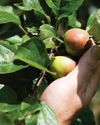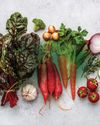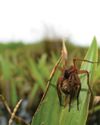Would you like gorgeous fresh cut flowers all summer? All you need is a handful of seed, a spare patch of soil, and five minutes a day.

Just plant five of each,” was the stern advice from Georgie Newbery, artisan British flower grower and florist extraordinaire, “or you’ll be wading through forests of cosmos.”
Of course, she knew perfectly well that newbie gardeners can’t bear to sow only a few seeds, when packets of seeds promise an abundance of jewel colours. Sure enough, despite the notes I wrote on her cutting-patch course, 10 months later I could barely find my way through swathes of crimson and hot pink cosmos, some as high as my head.
Growing my own flowers was an idea that started in a supermarket, three summers ago. Gazing at the flower buckets by the entrance, I felt torn. Flowers make me happy – but if I wanted one mixed bouquet a week on the kitchen table, I’d be shelling out £40 a month. Looking more closely at the flowers, I wasn’t that impressed, either – the lilies had been flown in from Africa, the stocks were squashed in their plastic wrapping and the roses looked almost industrial in their uniformity.
So I walked past the cut-flowers and, realising there was still time to start growing my own that summer, went home, dug the turf from a 3m x 4m chunk of our garden – and got planting.
I didn’t want an idyllic cottage garden border; I wanted flowers to cut for the house – and buckets of them. Minus any gardening knowledge, but with the help of a niftily predesigned planting plan and a tin of seeds, I managed to raise my own tiny, delicate plants for the first time ever.
There were some failures. My sweet peas were weedily unproductive, about 20% of my other seedlings died early on, and the slugs munched on my just-emerging dahlias.
This story is from the {{IssueName}} edition of {{MagazineName}}.
Start your 7-day Magzter GOLD free trial to access thousands of curated premium stories, and 9,000+ magazines and newspapers.
Already a subscriber ? Sign In
This story is from the {{IssueName}} edition of {{MagazineName}}.
Start your 7-day Magzter GOLD free trial to access thousands of curated premium stories, and 9,000+ magazines and newspapers.
Already a subscriber? Sign In

Guilt-Free Meat? - Should the world stop eating meat to tackle the climate crisis? Chris Baraniuk meets an experimental farmer who says we don't all have to become vegetarians
Should the world stop eating meat to tackle the climate crisis? Chris Baraniuk meets an experimental farmer who says we don't all have to become vegetarians. Livestock farming around the world is facing scrutiny because of its greenhouse gas emissions. Globally, the sector contributes somewhere between 11.1% and 19.6% of total emissions. Meat production is roughly twice as bad as the production of plant-based food, according to some analyses. And beef is the worst of all. Study after study has suggested that, in order to curtail the devastating effects of climate change, we ought to shift to a diet containing less meat - or even go vegetarian or vegan.

Discover Cider Country - Explore mellow golden countryside, pedalling between medieval villages, historic inns and fruitful orchards, on a delightful Herefordshire Cider Circuit adventure with Julie Brominicks
Explore mellow golden countryside, pedalling between medieval villages, historic inns and fruitful orchards, on a delightful Herefordshire Cider Circuit adventure with Julie Brominicks. I'm cycling Porter's Perfection, one of three cider circuits developed for Visit Herefordshire over the past few years. Each showcases a section of this bucolic county's loveliest villages, pubs, orchards and cidermakers via lanes suited to bicycles - e-bikes for hill-averse cyclists like me. The idea is to allow you to appreciate the sights, sounds and smells of cider country while traversing roads never meant for modern cars. If you have dodgy knees, or are keen to indulge in the local adult apple juice as you go (remember, it's illegal to cycle while under the influence), Visit Herefordshire also promotes cider bus routes.

TOP 10 WILD AUTUMN FOODS
Make the most of seasonal abundance with foraging tips and recipe ideas from wild food expert Liz Knight

The taste of England
Amid pastures farmed by her family for more than four centuries, Mary Quicke is reviving forgotten dairy traditions to produce delicious Devon cheeses

How to eat 30 plants a week
As science proves the many health-boosting benefits of eating at least 30 different plants each week, Hugh Fearnley-Whittingstall shares recipes to help you meet the magic target

RARE RAFT SPIDER MAKES A COMEBACK
Thanks to dedicated conservation work, this impressive but vulnerable arachnid is resurgent in East Anglia

SPECTACULAR STONEHENGE FINDS
Following the latest astonishing revelation about the Stonehenge Altar Stone's Scottish origins, Dixe Wills looks at recent discoveries that have changed the way we view this impressive and enigmatic Neolithic monument

GALLOWAY NATIONAL PARK DEBATE
Would this protected status bring welcome recognition and attention - or overcrowding and problems for farmers?

Farmers are valued, so why do they feel we don't care?
For farmers out in their fields in all seasons, worried about the future as dramatic levels of rainfall blamed on climate change damage their crops, inflation and uncertainty push up their costs and what they see as unfair imports threaten their livelihoods, here's a spot of unexpectedly good news: the rest of us think you are doing a good job.

Pumpkin patches
Find the perfect jack-o'-lantern for Halloween at a pick-your-own pumpkin patch. Some are simple affairs in tranquil countryside; others offer activities ranging from ghost trains to spooky mazes.